The Bariatric Walkers Market is estimated to be valued at USD 340.3 million in 2025 and is projected to reach USD 638.7 million by 2035, registering a compound annual growth rate (CAGR) of 6.5% over the forecast period.
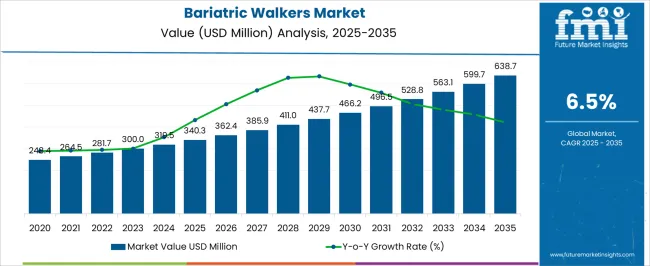
| Metric | Value |
|---|---|
| Bariatric Walkers Market Estimated Value in (2025 E) | USD 340.3 million |
| Bariatric Walkers Market Forecast Value in (2035 F) | USD 638.7 million |
| Forecast CAGR (2025 to 2035) | 6.5% |
The bariatric walkers market is witnessing consistent growth, supported by rising global obesity rates, aging populations, and the increasing need for mobility assistance devices with higher weight-bearing capacity. Demand is being fueled by greater emphasis on enhancing patient independence, safety, and rehabilitation outcomes. Advancements in materials and ergonomic designs are improving durability, maneuverability, and user comfort, encouraging broader adoption across healthcare facilities and homecare settings.
The market is also benefiting from government and insurance support for mobility aids in several regions, making bariatric walkers more accessible to patients in need. Manufacturers are focusing on developing lightweight yet sturdy designs that combine strength with portability, addressing the needs of overweight and elderly patients who require long-term mobility support.
Increasing awareness of fall prevention and the importance of maintaining mobility in obese and geriatric populations is further strengthening market penetration With continuous innovation in weight capacity ranges, materials, and ease of use, the market is expected to expand steadily, positioning bariatric walkers as a vital part of the global mobility assistance device landscape.
The bariatric walkers market is segmented by type of bariatric walker, material composition, weight capacity, features, end user, and geographic regions. By type of bariatric walker, bariatric walkers market is divided into Four-Wheeled Bariatric Walkers, Two-Wheeled Bariatric Walkers, Heavy-Duty Bariatric Walkers, and Folding Bariatric Walkers. In terms of material composition, bariatric walkers market is classified into Aluminum, Steel, Composite Materials, and Plastic Components. Based on weight capacity, bariatric walkers market is segmented into 401 Lbs - 600 Lbs, Up To 400 Lbs, 601 Lbs - 800 Lbs, and Above 800 Lbs. By features, bariatric walkers market is segmented into Adjustable Height, Brake Systems, Storage Options (Baskets, Racks), and Ergonomic Hand Grips. By end user, bariatric walkers market is segmented into Homecare Settings, Hospital Usage, Rehabilitation Centers, and Senior Living Facilities. Regionally, the bariatric walkers industry is classified into North America, Latin America, Western Europe, Eastern Europe, Balkan & Baltic Countries, Russia & Belarus, Central Asia, East Asia, South Asia & Pacific, and the Middle East & Africa.
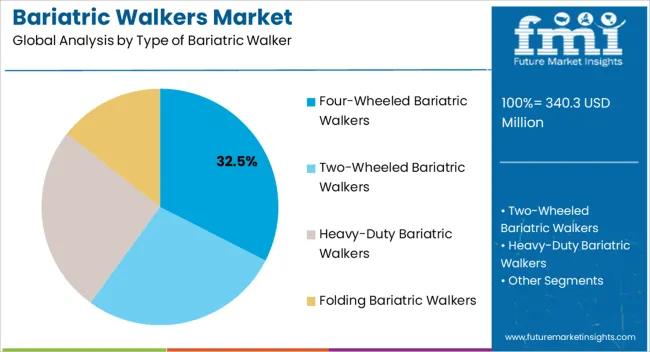
The four-wheeled bariatric walkers segment is expected to hold 32.5% of the bariatric walkers market revenue share in 2025, making it the leading product type. This dominance is being supported by the stability, balance, and mobility advantages offered by four wheels compared to standard walker designs. Users benefit from improved maneuverability on varied surfaces, reducing fatigue and enhancing independence in daily activities.
The inclusion of features such as hand brakes, cushioned seats, and storage options further enhances functionality and user convenience. Healthcare providers are increasingly recommending four-wheeled bariatric walkers for patients requiring extended use, as these designs improve adherence to mobility programs and contribute to better rehabilitation outcomes.
The segment’s growth is also driven by its ability to support higher weight capacities without compromising stability, making it suitable for obese individuals who need reliable support With ongoing design improvements and the availability of models tailored to patient comfort, this segment is anticipated to maintain leadership in the global bariatric walkers market.
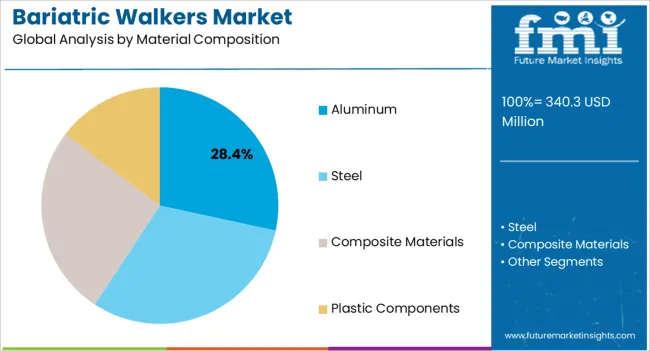
The aluminum material composition segment is projected to account for 28.4% of the bariatric walkers market revenue share in 2025, positioning it as the leading material choice. The dominance of aluminum is being explained by its optimal combination of lightweight construction and high durability, which enhances portability while maintaining strength for heavier users. This balance makes aluminum walkers easier for patients to handle and transport, encouraging greater independence and regular use.
Resistance to corrosion and ease of maintenance are additional factors that support long-term product life, contributing to cost-effectiveness for both healthcare providers and individual users. Manufacturers are prioritizing aluminum due to its versatility in design, allowing integration of advanced features without significantly increasing overall weight.
Growing demand from homecare settings, where ease of mobility is critical, is further accelerating adoption As patient safety and user comfort continue to drive purchasing decisions, aluminum-based bariatric walkers are expected to retain their leading position in the market over the forecast period.
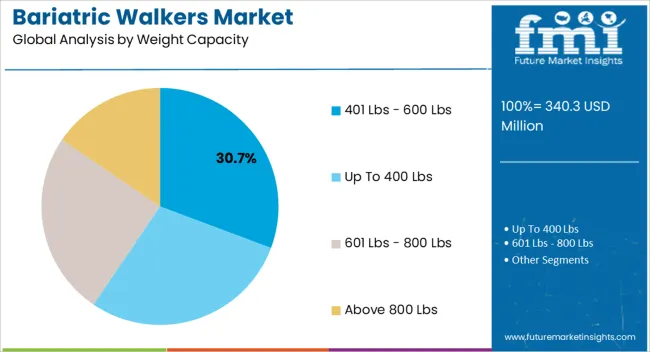
The 401 lbs to 600 lbs weight capacity segment is projected to capture 30.7% of the bariatric walkers market revenue share in 2025, establishing itself as the dominant weight capacity category. Its leadership is being driven by the growing need for mobility aids that accommodate higher weight ranges while ensuring user safety and comfort. Devices in this category offer reinforced frames and enhanced stability features, making them suitable for obese patients requiring dependable long-term support.
The segment is experiencing growth as healthcare providers increasingly prioritize walkers that minimize the risk of falls and provide greater confidence to patients during mobility training. The balance between strength and maneuverability offered by this weight capacity range makes it a preferred choice for both clinical and homecare applications.
Rising prevalence of obesity worldwide, combined with aging demographics, is contributing to sustained demand With ongoing product innovations that improve ergonomics and usability, this weight capacity segment is expected to remain a key driver of the global bariatric walkers market.
The countries like USA and United Kingdom are combating bariatric diseases for decades. Bariatric ailments are caused due to obesity. Obesity is not only an ailment but it is a deep rooted lifestyle disease which can further aggravate and can usher several other diseases into the body. A massive population of the world is at the brink of aging and a major chunk of that population is obese and they are fighting a long term war with their extra flabs.
It’s a challenge for the healthcare leaders to support and create a healthcare friendly climate for this massive population of over weight adults. In the last few years the healthcare leaders of USA, UK, China, Japan and India are mulling over this issue. The top honchos in the healthcare ecosystem are planning to create a proper support system for these people who are crippled by age.
The industry insiders believe that the bariatric walkers market will grow and shall churn out a whooping revenue from the markets which are directly related with the obese elderly population. The constant demand will generated in several potential markets across the globe which will further spike the periphery of the Bariatric Walkers market.
The Bariatric walkers are normally light weight and tailor made for bariatric elders. They are made of aluminium and they are normally equipped with two button mechanism which also makes them portable and user friendly.
There are several other bariatric walkers available in the markets made of plastic and wood. But the bariatric walkers markets are predominated by aluminium made walkers. They can shoulder a weight of 600 lb. The size of the bariatric walkers market will soar in the recent future.
Amongst many the United States is one of the leading manufacturers and procurers of bariatric medical items such as Bariatric walkers. Presently the bariatric walkers market in USA worth few billions and it will jump in the coming few years.
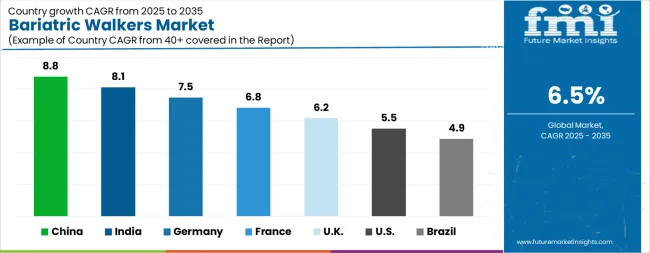
| Country | CAGR |
|---|---|
| China | 8.8% |
| India | 8.1% |
| Germany | 7.5% |
| France | 6.8% |
| UK | 6.2% |
| USA | 5.5% |
| Brazil | 4.9% |
The Bariatric Walkers Market is expected to register a CAGR of 6.5% during the forecast period, exhibiting varied country level momentum. China leads with the highest CAGR of 8.8%, followed by India at 8.1%. Developed markets such as Germany, France, and the UK continue to expand steadily, while the USA is likely to grow at consistent rates. Brazil posts the lowest CAGR at 4.9%, yet still underscores a broadly positive trajectory for the global Bariatric Walkers Market. In 2024, Germany held a dominant revenue in the Western Europe market and is expected to grow with a CAGR of 7.5%. The USA Bariatric Walkers Market is estimated to be valued at USD 129.2 million in 2025 and is anticipated to reach a valuation of USD 221.2 million by 2035. Sales are projected to rise at a CAGR of 5.5% over the forecast period between 2025 and 2035. While Japan and South Korea markets are estimated to be valued at USD 16.1 million and USD 8.9 million respectively in 2025.
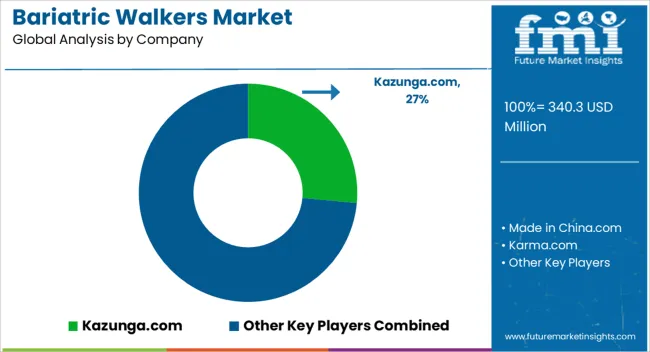
| Item | Value |
|---|---|
| Quantitative Units | USD 340.3 Million |
| Type of Bariatric Walker | Four-Wheeled Bariatric Walkers, Two-Wheeled Bariatric Walkers, Heavy-Duty Bariatric Walkers, and Folding Bariatric Walkers |
| Material Composition | Aluminum, Steel, Composite Materials, and Plastic Components |
| Weight Capacity | 401 Lbs - 600 Lbs, Up To 400 Lbs, 601 Lbs - 800 Lbs, and Above 800 Lbs |
| Features | Adjustable Height, Brake Systems, Storage Options (Baskets, Racks), and Ergonomic Hand Grips |
| End User | Homecare Settings, Hospital Usage, Rehabilitation Centers, and Senior Living Facilities |
| Regions Covered | North America, Europe, Asia-Pacific, Latin America, Middle East & Africa |
| Country Covered | United States, Canada, Germany, France, United Kingdom, China, Japan, India, Brazil, South Africa |
| Key Companies Profiled | Kazunga.com, Made in China.com, Karma.com, RKM Global Products, and Xcellance Medical Technology |
The global bariatric walkers market is estimated to be valued at USD 340.3 million in 2025.
The market size for the bariatric walkers market is projected to reach USD 638.7 million by 2035.
The bariatric walkers market is expected to grow at a 6.5% CAGR between 2025 and 2035.
The key product types in bariatric walkers market are four-wheeled bariatric walkers, two-wheeled bariatric walkers, heavy-duty bariatric walkers and folding bariatric walkers.
In terms of material composition, aluminum segment to command 28.4% share in the bariatric walkers market in 2025.






Our Research Products

The "Full Research Suite" delivers actionable market intel, deep dives on markets or technologies, so clients act faster, cut risk, and unlock growth.

The Leaderboard benchmarks and ranks top vendors, classifying them as Established Leaders, Leading Challengers, or Disruptors & Challengers.

Locates where complements amplify value and substitutes erode it, forecasting net impact by horizon

We deliver granular, decision-grade intel: market sizing, 5-year forecasts, pricing, adoption, usage, revenue, and operational KPIs—plus competitor tracking, regulation, and value chains—across 60 countries broadly.

Spot the shifts before they hit your P&L. We track inflection points, adoption curves, pricing moves, and ecosystem plays to show where demand is heading, why it is changing, and what to do next across high-growth markets and disruptive tech

Real-time reads of user behavior. We track shifting priorities, perceptions of today’s and next-gen services, and provider experience, then pace how fast tech moves from trial to adoption, blending buyer, consumer, and channel inputs with social signals (#WhySwitch, #UX).

Partner with our analyst team to build a custom report designed around your business priorities. From analysing market trends to assessing competitors or crafting bespoke datasets, we tailor insights to your needs.
Supplier Intelligence
Discovery & Profiling
Capacity & Footprint
Performance & Risk
Compliance & Governance
Commercial Readiness
Who Supplies Whom
Scorecards & Shortlists
Playbooks & Docs
Category Intelligence
Definition & Scope
Demand & Use Cases
Cost Drivers
Market Structure
Supply Chain Map
Trade & Policy
Operating Norms
Deliverables
Buyer Intelligence
Account Basics
Spend & Scope
Procurement Model
Vendor Requirements
Terms & Policies
Entry Strategy
Pain Points & Triggers
Outputs
Pricing Analysis
Benchmarks
Trends
Should-Cost
Indexation
Landed Cost
Commercial Terms
Deliverables
Brand Analysis
Positioning & Value Prop
Share & Presence
Customer Evidence
Go-to-Market
Digital & Reputation
Compliance & Trust
KPIs & Gaps
Outputs
Full Research Suite comprises of:
Market outlook & trends analysis
Interviews & case studies
Strategic recommendations
Vendor profiles & capabilities analysis
5-year forecasts
8 regions and 60+ country-level data splits
Market segment data splits
12 months of continuous data updates
DELIVERED AS:
PDF EXCEL ONLINE
Bariatric Rollator Walkers Market Size and Share Forecast Outlook 2025 to 2035
Bariatric Surgery Device Market Forecast and Outlook 2025 to 2035
Bariatric Walking Aids Market Size and Share Forecast Outlook 2025 to 2035
Bariatric Lifts Market Size and Share Forecast Outlook 2025 to 2035
Bariatric Transport Wheelchairs Market Size and Share Forecast Outlook 2025 to 2035
Bariatric Patient Room Market Size and Share Forecast Outlook 2025 to 2035
Bariatric Beds Market Analysis and Forecast for 2025 to 2035

Thank you!
You will receive an email from our Business Development Manager. Please be sure to check your SPAM/JUNK folder too.
Chat With
MaRIA